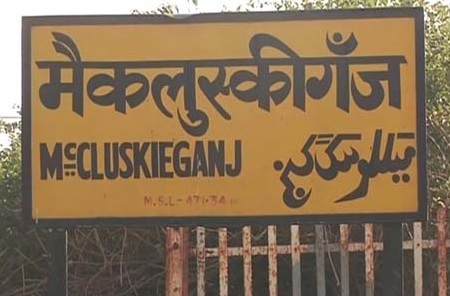
Holding On : The Anglo Indian Settlement in McCluskiegunj
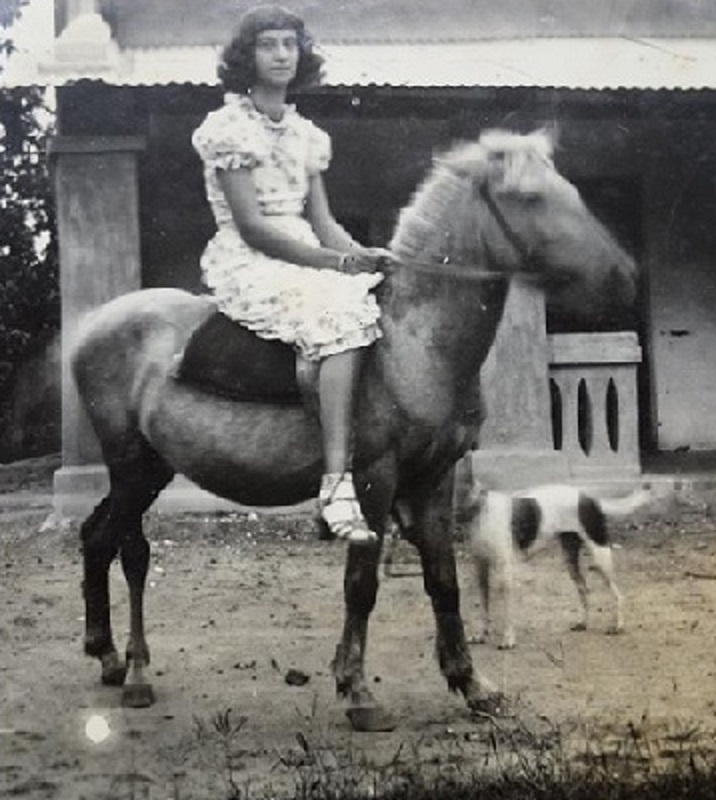
Author’s grandaunt Ivy Hourigan (Sheperd) was a resident of McCluskiegunj. The Anglican lifestyle is apparent from the photograph
Editors Note: About seventy years ago in early 1930s Anglo Indians started a unique colony in the jungles of Chottanagpur which is today known as McCluskiegunj. The Anglo Indians called the place their Mooluk (homeland) and positioned the place as Chotta England (Little England). That dream today lies dimmed, with most of the Anglo Indian families having migrated. However people like Malcolm Hourigan, an Anglo Indian resident of McCluskiegunj, believes that the dream cannot be written off yet. Malcolm runs a student hostel at McCluskiegunj, writes a popular blog on the Gunj, documents the history of the place and lobbies for betterment of the place. This article has been written exclusively for Probashi by Malcolm.
On 11 Feb 2014, Anglo Indian residents of McCluskiegunj held a meeting at the Don Bosco School to reconstitute the long defunct burial ground committee. McCluskiegunj graveyard, itself tells the story of decline. While the older parts have stone and marble graves , the newer ones are unmarked.
I silently sat through the meeting, thinking whether we will need the services of our burial ground for long. There are only 6-7 Anglo Indian families left in McCluskiegunj, compared to it’s hey days when about 350 such families called McCluskiegunj their home. Has destiny given these last remaining families the job of playing the Last Post as McCluskiegunj slowly faded into history, I wondered.
A long forgotten saying by Norman Cousins came shooting back “the tragedy of life is not death, but what we let die inside of us while we live’.  In those lines came a flurry of thoughts. Probably we can still make an effort to revive McCluskiegunj. Probably the Merediths, the Jennings, the D’Rozarios, the Barretts, the Hourigans, the Perkins, the D’Costas or the Mendies hold on to the fort. Probably the Mundas, the Prasads, the Singhs could be partners. Probably we could preserve the legacy of McCluskiegunj for the posterity to remember. Probably we could even hope that Anglo Indians from across the world and India would trickle back. Probably we could hope to complete the unfinished painting which ET McCluskie started with a flourish on this 10000 acre canvas. It is with these hopes that I write this article.
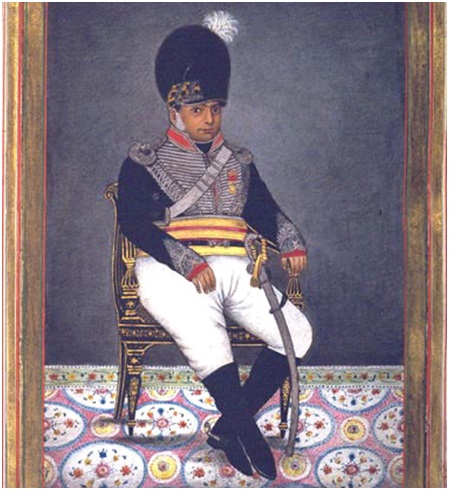
James Skinner (1778- 1841), son of a Scotsman and a Rajput woman was the first Anglo Indian to achieve distinction. He raised a freelance force, which fought on behalf of many Indian ruling princes. Skinner’s irregular cavalry was called “Skinners’ Horse”. It became the finest regiment of the East India Company. Skinner’s Horse later became a part of independent India’s Army. In 1978 the Indian Government issued a postage stamp to celebrate 175 years of the Skinners’ Horse Regiment.
At the stroke of the midnight hour on 15 August 1947, when the Anglos were leaving India and the Indians were taking over, one community was left in the cusp of destiny – The Anglo Indians. The Anglo Indian is a term used to describe people of mixed British and Indian parentage (the Constitution of India has a broader definition for Anglo Indians and includes individuals with mixed European and Indian heritage or Europeans who have become naturalised citizens of India) , found themselves in the lurch. They were not welcome in Britain, and were looked with suspicion by the Indians.
This community had been the nuts and bolts of the British administration fuelled by its knowledge of English and the trust factor of a shared ancestry (though in parts). Anglo Indians ran the Customs and Excise, Post and Telegraphs, Forestry Department, the Railways, Shipping, Tea, Coffee and Tobacco plantations, the Coal and Gold fields. Anglo Indians became teachers, nurses, priests, doctors and secretarial assistants. The railway colonies across the country from Khurda Road to Ajmer had Anglo Indian enclaves with its red tiled bungalows, manicured lawns, card games, pretty babies in prams, wives playing badminton in the evening, music, dances, lots of tobacco smoking and drinking at the club house. The Sunday church congregation would see them in immaculate western turnout. However not all Anglo Indians lead a privileged life. A number of them could be found in the slums and poor parts of urban India especially Kolkata. Here they were called ‘Safed Chooha’ (white rats). One has to read the book Indian English by Jillian Haslam to get this perspective.
The Anglo Indians developed a distinct culture and a world outlook given their mixed parentage. Of the many rituals which are uniquely Anglo Indian, one which I remember from my childhood is the baking of the Christmas cake. Each Anglo Indian homemaker had a secret cake recipe handed down to her by her mother or mother in law. The local baker would come home and the lady of the house would provide the ingredients and have the same mixed under her supervision. The mixed ingredients were put into a dozen of cake tins, with the family name written on the cans, lest the baker mixed up. Nothing could be more blasphemous than baker returning in the evening with someone else’s cake.
The building up of an Anglo Indian community was a part of a well thought out strategy of the British. The East India Company would encourage its British male employees to take up Indian wives so as to create a community with mixed ancestry. This mixed community was expected to be a buffer between the British and the local population. The East India Company paid 15 silver rupees for each child born to an Indian mother and a European father.
To the British however, the Anglo Indians were convenient but never equals. Their knowledge of English and loyalty to the Anglo roots were critical qualifications. To the Indians they were the ‘Kutcha Sahibs’ (half baked English) - cogs in the wheel of the British India, whose loyalty lay with the enemy.
This distance maintained by the British with the Anglo Indians persisted despite significant contribution by the community. During World War 1 about 8000 Anglo-Indians fought in Mesopotamia, East Africa,  and in the European theatre - eleven Anglo-Indians were awarded Victoria Crosses. In World War II they fought at Dunkirk and Anglo Indian pilots flew in the battle for Britain. The contribution in the battle field continued even after India got Independent- Air Vice-Marshal Maurice Barker was India’s first Anglo-Indian air marshal. At least seven other Anglo-Indians subsequently reached that post, a notable achievement for a small community. A number of others have been decorated for military achievements. Air marshal Malcolm Wollen is considered a hero of the 1971 Bangladesh war.
Anglo Indian contribution to sports has been significant. It was indeed a unique moment when India faced Australia in the hockey
semi-finals of the 1960 Olympics in Rome. The captains who came face to face were both Anglo-Indians, Leslie Claudius representing India and Kevin Carton representing Australia.
It was as early as the 1920s that the Anglo Indian started to feel alienated. While on one hand political compulsions made British to accommodate Indians in government jobs, hitherto the monopoly of the Anglo Indians. On the other hand the burgeoning Indian Independence movement had started to put faint lettering on the wall that it was a matter of time that the British would be forced to leave. The Anglo Indians did not know which side to take. They feared that neither British would take them; neither Indians would want them to stay.
This dilemma is brought out very well by Sadat Hasan Manto in his story Toba Tek Singh, set in a lunatic asylum, where the inmates are to be exchanged between India and Pakistan. Two Anglo Indians in the European ward would spend hours discussing “Would the European ward be abolished? Would they get breakfast? Instead of bread, would they have to make do with measly Indian chapattis?â€
It was time for the 8,00,000 strong Anglo Indians to reassert themselves as a community, or risk being bypassed and subsumed.
Every race needs symbols to rally around and a homeland is one such powerful symbol. The Anglo Indians had none, and they attempted to create one, which was to be known as McCluskiegunj. The drivers in the mission to create the Anglo Indian homeland were two prominent Anglo Indians- Sir Henry Gidney and Ernst Timothy McCluskie.
Sir Gidney, a brilliant medical doctor and a colourful personality petitioned the British to grant swathes of land in Andaman and Nicobar Islands where the Anglo Indians could establish their homeland. Â An advance party of ten Anglos was sent, of whom three perished and seven returned home after a year. The portend did not seem favourable. The rather preposterous idea was rejected by the British.
ET McCluskie, a businessman and friend of Sir Gindy, was the part of the Anglo Indian elite in Calcutta. His father was an Irish railway man and his mother an Indian Brahmin , McCluskie had a more practical proposition. He had been able to convince the Raja of Ratu ( in Chotanagpur plateau) to lease out 10000 acre of land on a perpetual lease near the station of Lapra, about 62 kms from Ranchi. Here he proposed to setup the homeland for the Anglo Indians. The location offered the three Rs essential to McCluskie for the success of his dream- Railway, River and Road. However McCluskie had forgotten one important R- Remuneration (Livelihood) which was to be the nemesis. We will return to the demise of McCluskiegunj later.
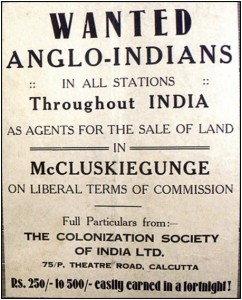 The Colonisation Society of India, a cooperative, was formed in 1933 into which the Anglo Indians could buy shares and get a plot of land in return. The membership was given to people with European lineage, not necessarily British. So Portuguese Indians, French Indians etc also bought land. McCluskie, an astute marketer, appealed to the sense of pride in Anglo heritage. The prospectus of the Colonisation Society extolled how a country of Anglo Indians will rise and show to the world what Anglos were capable of, and earn respect of all communities of India. Here would be a ‘Chotta England’ (small England), amidst the salubrious environment. And Anglos will cultivate the land and sustain a community as blue blooded as possibly can be - a corner of India culturally forever European.
The Colonisation Society of India, a cooperative, was formed in 1933 into which the Anglo Indians could buy shares and get a plot of land in return. The membership was given to people with European lineage, not necessarily British. So Portuguese Indians, French Indians etc also bought land. McCluskie, an astute marketer, appealed to the sense of pride in Anglo heritage. The prospectus of the Colonisation Society extolled how a country of Anglo Indians will rise and show to the world what Anglos were capable of, and earn respect of all communities of India. Here would be a ‘Chotta England’ (small England), amidst the salubrious environment. And Anglos will cultivate the land and sustain a community as blue blooded as possibly can be - a corner of India culturally forever European.
Many bought into McCluskie’s marketing glib. The Anglo Indians came to this wilderness and built their Anglican bungalows with flower gardens and tiled slanted roofs. They built two churches, a club, a abattoir, a post office, poultry farms and horse stables. They brought their pianos, their heavy wooden chests, their riding breeches, their rifles and shotguns, their chatter, their party gowns, lace curtains, rum cakes and beer. Through the verdant forest would waft the voice of Helen Morgan singing ‘Why I was born’.
For the initial settlers including my maternal great grandfather,it was not easy. The initial houses were built of bamboo, and big game
and other wild animals had to be countered with. Being a good hunter was a necessity to be able to make the forest a home. It is to the credit of the pioneers that the land was made hospitable for setting up of the settlement.
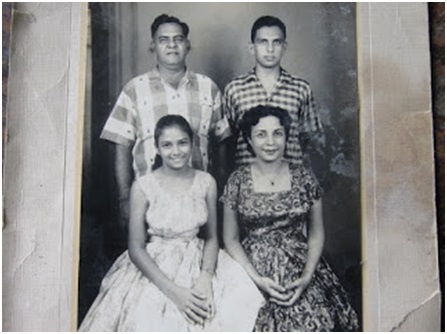
This is the Thorpe family of McCluskiegunj. They own property here which is being claimed by the Malhaar tribe. The old caretaker expired and her kin took charge and care of the bungalow and property, measuring nearly 7 acres, since then. There is a real threat of the property being encroached and the current caretaker needs to get in touch with the owners. The info about Robert Thorpe is that he is in Australia , but no phone number, or email or surface address is available with anybody here in the Gunj. This is the story of many bunglows at McCluskiegunj.
McCluskie despite his business acumen has erred on a very basic point. He had expected that the Anglo Indians- the erstwhile railwaymen, box-officewallahs and teachers would turn out also to be expert farmers. The livelihood options other than farming were rather limited at this place. The highly anglicised and better off Anglo Indians who could afford to buy land at McCluskiegunj were not ready to roll up their sleeves and start to farm. Â Â Another factor stood against the McCluskiegunj dream. Anglo Indians who were mostly service class did not have the business acumen, penchant for savings and acceptance of a spartan living in their psyche. The economic base of McCluskiegunj was not based on any realistic assumptions and would eventually lead to its downfall.
Take the case of my maternal grandfather Harris Mendies. He ran the only bus service out of McCluskiegunj called the Ganga Jamuna bus service. This once a day operation connected McCluskiegunj and Ranchi. He also had stake along with a Sikh gentleman in an ice factory in nearby Ramgarh. Harry Mendies was a big spender and did not have a single atom in his body which allowed him to save for the rainy day. To make things worse, he had to maintain a large family of 11 members. With competition coming in, the bus service business started to falter and income began to dwindle. However Harry refused to make proportional reduction in his spending habits. Soon the stake in the ice factory was sold. With financial crisis refusing to abate, the seven inherited bungalows were disposed one after the other. Things came to such a pass that in his later years Harry had to borrow money for a swig of country liquor. I am not writing this to deride or make a snide comment on my grandfather, but am mentioning this as an example of how the Anglo Indian community allowed the initiative to make McCluskiegunj a happening place slip.
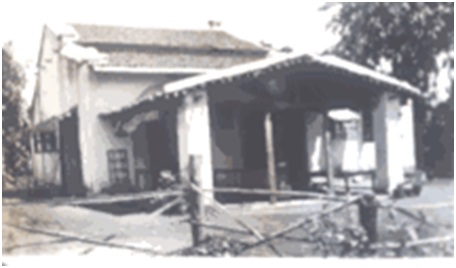
The Dobson Cottage in McCluskiegunj, now no longer exists. The Dobsons migrated to Kolkata and the bungalow became derelict.
After McCluskie died in 1935, the Lapra settlement was named as McCluskiegunj. However by 1940 the game was up, Only 1/5th of the Rs.500000 paid up capital was subscribed. Only 6800 acres had been sold and eventually by 1955 the Colonisation Society has folded up. McCluskiegunj was a place for retired people, others started to move out, some to foreign lands or to cities for jobs.
Unlike the Parsis who made Jamshedpur into a thriving industrial area, the Anglos could not repeat a similar feat. The fate of McCluskiegunj fell prey to an experiment which had not factored in the economic variables.
Most of the younger generation left Chota England (as McCluskiegunj was known) for Bada England (United Kingdom), Australia and United States. My father’s elder brother and younger sister were amongst the early out migrants. Migration has its sad tales also. My mother’s elder sister Dorothy migrated to England, and this was the last we heard of her. Despite searching of her whereabouts through common friends in England, she could not be traced. We shudder to imagine that she might be dead, with no family near her during her difficult times. Some left for city jobs. However aberrations like me came back to McCluskiegunj to keep the faint flame alive. When I came to McCluskiegunj in 1997 there were just 12 Anglo Indian families down from it’s hey days of 350 odd Anglo Indian households.

The first settlers faced lots of challenges including wild animals. Seen in the photo Allen Mendies( with gun), maternal great grandfather of the author with the two leopards which he killed. The leopards were roaming around his house in McCluskiegunj. The young boy is the author’s maternal grandfather Harry Mendies. Note that the house is made of bamboo. Initial prospectors stayed in makeshift houses till they were convinced of settling permanently
My connection with McCluskiegunj goes back to three generations from both my paternal and maternal side. My maternal great grandfather who was an British gentleman came to McCluskiegunj as one of the early pioneers. In previous paragraphs I have spoken at length about my maternal grandfather, Harry ÂMendies. My paternal side are Irish and relatively new to McCluskiegunj. My grandfather came from Bengal in 1970ies and settled here. My father was employed with TISCO. My childhood was mostly spent in a place called Ghato better known as West Bokaro in Hazaribag district. However I do have great childhood memories of McCluskiegunj where I used to come during holidays.
I after doing a number of jobs in Kolkata ultimately succumbed to the calling of McCluskiegunj. My coming back the demographers would term as an  instance of reverse migration. This was in midst of other Anglo Indian families out migrating from McCluskiegunj. Why did I come back to a place being abandoned by others. To me the reasons are simple - I liked the serenity of McCluskiegunj, the footprints of my ancestors were here, my wife Charmaine once had family (the Thipthropes) here, and importantly a new livelihood option had come up in McCluskiegunj.
In 1997, the Don Bosco Academy started a school at McCluskiegunj on the initiative of Alfred George D’Rozario who was then the MLC of undivided Bihar. Being the only English medium school in the region admission seekers flocked in, far outstripping the seats available. It is to the foresight of Mr D’Rozario that it was deliberate strategy of not having any lodging facility for students at the school. The hostels were to be run by the Anglo Indian families at McCluskiegunj from their residences.
This meant a promising livelihood option. Also there was now demand for teachers not only at Don Bosco, but at other schools which subsequently opened.  Anglo Indians with their felicity with the English language had a distinct advantage. Today there are 40 hostels, four of which are run by Anglo Indian families - St. Jude’s Hostel, Saint Luke’s Hostel, School View Hostel,
and Gordon’s Hostel. I run the Saint Luke’s Hostel.
While McCluskiegunj is not known widely, it is quite popular with tourists from West Bengal for which the credit goes to the Bengali writer Buddhadev Guha. He owned the bungalow “Manjulika”, named after his mother. He wrote many of his works at the Gunj. The novel Ektu Ushnotar Jonno is a love story based in McCluskiegunj. Aparna Sen owned a house here and Uttam Kumar, the Bengal super star, visited McCluskiegunj for shooting of his film Shiulibari (1962) along with Arundhati Devi his co star in the film.
The old timers recall the lost glory of McCluskiegunj. Noel Gordon then a boy of 8-9 years moved to McClukiegunj with his family from Kolkata. Back in 1958 it seemed to be a good idea, to move into an enclave which had familiar people with similar tastes. Uncle Gordon recollects that the train to McCluskiegunj would steam in from Barkakana at around 4.30 in the morning. Today Uncle Gordon and his son Nelson (Bobby) run the only guesthouse in McCluskiegunj called the Gordon Guest House. During Uncle Gordon’s time there were many Anglo Indians to be seen in McCluskiegunj, and it had a life of its own. There were bakeries and departmental stores run by Anglos. The goods available in the shops here were not even available at Ranchi, may that be good quality cosmetics, China silks or the latest gramophone records. And there were Austins for long drives and a lift in a bullock cart for short trips. Walking was not only a good idea but also a necessity, since the bungalows were far flung and the nearest neighbour out of line of sight. And there used to be Puja balls and Christmas carols and the dances at the club were ever so popular with the residents. And there was Mrs Thipthrope whose jams and jellies were famous not only in the town, but people from Delhi would order for her products. She is no more and no one at McCluskiegunj makes jams and jellies anymore.
In the fifties and sixties there was a dentist Dr P Bedell who used to move around visiting his patients at their bungalows on his horse. Since there was no other doctor here, Dr Bedell would also attend to patients suffering from general diseases. Seriously ill patients had and still have no option but to move out for specialised treatment. Mandar, 35 kms from McCluskiegunj, had the nearest hospital run by foreign missionaries. This over a century old hospital known as the Holy Family hospital still exists at Mandar. However the facilities at this hospital are not as good as it used to be in the olden days.
McCluskiegunj has had its share of the Wild West. The Friday market at Hesalong village which neighbours McCluskiegunj hosts the oldest weekly market. Where there is commerce, there is money, and this fact did not go amiss to the dacoits in the area. There were occasional dacoities in the area by dacoits on horseback carrying guns. They  would explode bombs to scare people. The last large scale dacoity in the area took place in 1975. While it is unlikely that police has become more efficient, most probably the dacoits have found greener and more profitable ventures. It does not make much business sense - for the return on investment for the dacoits in robbing a small weekly market is not very high.
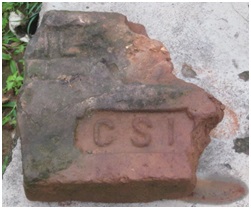
Chip of the old block: A brick with CSI (Colonial Society of India) inscribed. Such bricks were used to build the initial set of houses at McCluskiegunj
Anglo Indians as a community have been attached to the Railways in many capacities, may that be supervising track laying, loco inspectors or manning the steam engine or providing managerial and technical support. There is another interesting association with the railways in which one Anglo Indian family was involved. In the early fifties an Anglo Indian couple Mr and Mrs Kearney, who were among the first settlers, ran the only canteen at McCluskiegunj railway station. Mrs Kearney continued to run the canteen even after her husband Bill Kearney expired. She sold not only tea but also homemade biscuits and bread. After Mrs Kearney passed away the canteen continued operation under Mrs Kearney’s servant Majid Ansari who finally became the owner. With time, the Railway decided to rebuild the canteen, but refused to allot the canteen to Majid since he owed rent to the Railways. The canteen did good business when the Kearney’s were at the helm of the affairs. The steam engine run trains would stop for more than half an hour at  McCluskiegunj for topping up the water tanks. However with advent of diesel engines, the stoppage reduced to two minutes and the business declined.
As things stand today, McCluskiegunj has a number of derelict bungalows with the residents having long left. The walls which have seen better days now remain cracked, the roofs leaking and the tiles chipped. Many of the houses have been bought by locals and used for storing agricultural produce or have been converted into student hostels. Many bungalows remain abandoned because the inheritors are not in the country, and the care takers have long died or left.
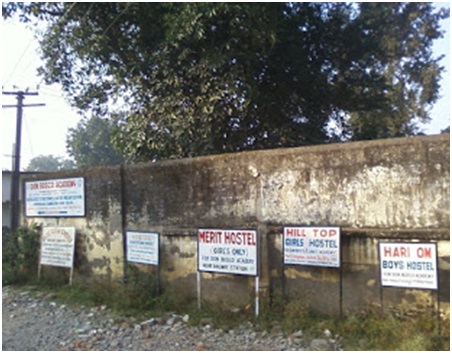
Student Hostels is the biggest economic driver of the McCluskiegunj. Presently there are 40 hostels, 4 of which are run by Anglo Indian families.
For the seven Anglo Indian families who still live here, the club remains silent, the Christmas carols are muted, and the hope for the place has somewhere disappeared in the creases of their faces. The Anglo Indians culture has slowly started to fade. In normal course we eat Indian food of subzi, roti and dal. Once in a while we do cook Anglo Indian recipes like vegetable stew, chicken roast, yellow rice & jalfraizi, pepper-water and puddings etc. Our British accented English is also getting an Indian tinge. Earlier the women folk would wear skirts and blouses, bell bottoms accessorized with scarves and hats. Now it is mostly sarees and salwar kameez.
I feel there still remains a lot to look forward to. Tourists come to this place, and also the descendants of the old residents mostly in search of the family graves and records. Recently the Government of Jharkhand has declared McCluskiegunj as a place of tourist interest. This would bring funding and infrastructure to the place. Tourism can potentially be a promising economic driver.
There can and should be no free lunches. The onus is as much on the residents as it is on the state government. The residents have to make an effort to maintain the character of McCluskiegunj not only for tourists but also as a tribute to our ancestors who dreamt of a homeland for the Anglo Indian community. There is an urgent need to document the available records, photographs, oral history before it is lost. This has to be put up on display at a museum in McCluskiegunj. There is also a need to inform and educate the Anglo Indian Diaspora about the importance of McCluskiegunj and encourage them to invest in property and also in preservation of the place.
The biggest issue which McCluskiegunj faces today is the coal siding planned here. This will throw up coal dust polluting the environment of the Gunj.  It is also apprehended that Coal India might extend its Rohini coal mining project up to Hesalong, a village which is part of McCluskiegunj. The first victim of this would be the Janet Academy, a popular school, which falls within the earmarked mining area.
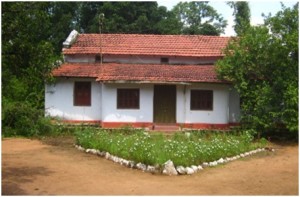
This bungalow at McCluskiegunj which once belonged to Buddhadev Guha, the man credited with making McCluskegunj popular by portrayal of the place in his novels in bangla. Original owner was Allen Menedis who sold the house to the Gabrails, who further sold the house to Guha. Guha sold the house to cine actress and now an acclaimed director Aparna Sen, who in turn sold to one Mr Mitra. The house presently belongs to the brother of the former Union minister Subodh Kant Sahay.
In a positive development Mr Glen Galstuan, Anglo Indian MLA, Jharkhand, raised the issue of the coal siding in the assembly.  Mr. Hemant Soren, Hon’ble Chief Minister of Jharkhand assured on the floor of the assembly that McCluskiegunj will be saved from getting ruined. Finally, in mid August 2014, all activity in relation with the coal siding was stopped. We hope that this is not a temporary respite but a permanent solution.
We do not want McCluskiegunj to be known as Chotta England. We wish McCluskiegunj to be known as an example that India cares for her diversity of culture and history.
And may I end this article with a quote from Frank Anthony, one of the tallest leaders the Anglo Indian community has ever produced. “Let us always remember that we are Indians. The community is Indian and it has always been Indian. Above all it has inalienable Indian birthrightâ€
Ms Kitty Texeria (Munda), the most well known resident of McCluskiegunj
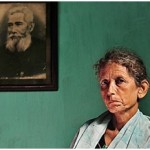 McCluskiegunj given its history and the romanticism of a lost world has had its fair share of journalists, writers, documentary film makers and television crews. And almost all of them have featured one lady, popularly known as Kitty Maam. Ms Kitty Texeria (Munda) is popular because she has broken the stereotype of the Anglo community. She had no qualms in mixing with the local tribal community and marrying a local tribal boy. She is a survivor, when the fortunes of many Anglo Indian families settled n McCluskiegunj failed and they moved out, she stayed back. She is a familiar face for us, living in McCluskiegunj with her Husband (Ramesh), son (Robert) and daughters (Sylvia, Yvonne, Linda ). There was a time when she used to sell fruits at the McCluskiegunj railway station, however now the family is little better off with the children earning.I find the best account written about Kitty and her mother to be that by the celebrated British journalist Ian Jack. I reproduce an excerpt (written in late 1970) from Ian’s book – The Country Formerly Known as Britain
McCluskiegunj given its history and the romanticism of a lost world has had its fair share of journalists, writers, documentary film makers and television crews. And almost all of them have featured one lady, popularly known as Kitty Maam. Ms Kitty Texeria (Munda) is popular because she has broken the stereotype of the Anglo community. She had no qualms in mixing with the local tribal community and marrying a local tribal boy. She is a survivor, when the fortunes of many Anglo Indian families settled n McCluskiegunj failed and they moved out, she stayed back. She is a familiar face for us, living in McCluskiegunj with her Husband (Ramesh), son (Robert) and daughters (Sylvia, Yvonne, Linda ). There was a time when she used to sell fruits at the McCluskiegunj railway station, however now the family is little better off with the children earning.I find the best account written about Kitty and her mother to be that by the celebrated British journalist Ian Jack. I reproduce an excerpt (written in late 1970) from Ian’s book – The Country Formerly Known as Britain
I first heard about Kitty from Mrs Tip-Top†She’s a good looking girl but terribly wild. She goes to the station and sells produce. It’s sad. She got mixed up with some tribal fellows and now she walks about barefoot and all, and only speaks to her mother in Hindiâ€.  Mrs Tip-Top was right. When I saw Kitty at the station she did indeed look pretty and wild, with her loose hair and bare feet, like a browner version of one of Russell Flint’s dancing gypsies. She hawked little oranges to passengers who passed money out through the bars on the carriage windows, and then in the long gaps between trains, helped some tribal men to brew country liquor in a drum at the foot of the signal post. She and her mother live in a bungalow called Woodlands high up on a tree-covered hill to the south of the station. There was no road to the house and the trees completely obscured it; even old McCluskiegunj hands tended to forget it was there.   On the final day of my last visit I decided to walk up this hill. I took the path east from the station, past the spoil heaps of locomotive cinders and then followed it south up a sloping field of red earth until I reached an unkempt orchard of lime, guava and mango trees. This was Mrs. Texeira’s land and in the middle of it stood the ruin of her bungalow, Woodlands. There was only a little glass in the windows and the holes in the asbestos roof had been stuffed with rags. Kitty’s mother, Majory took me into the parlour, where goats were nuzzling, some old wicker chairs and the floor was strewn with leaves. A Winchester Shotgun lay upright in one corner “Mine†said Mrs Texeira, “You need it in these partsâ€. She was old, poor and under-nourished, as tattered as her bungalow. She wore a ragged blue cardigan and white crepe stocking on her stick like legs. At first she seemed half – mad with bitterness and despair. The tribals had put a spell on her daughter; the Bengalis who wanted to buy her land were cheats. We talked for an hour or two and Mrs Texeira sucked on her biris, her cheap Indian cigarettes, and grew calmer. She was pleased by my interest in her ornaments. There were still a few pictures and books. On the wall hung a tinted photograph of a couple in smart European clothes holding a baby- the woman with bobbed hair and a neat white blouse, the man in a blazer and white flannels. That was Mr and Mrs Texeira and the infant Kitty. On a shelf stood copies of Little Women and What Katy Did, crisp with age and white- ant holes. Mrs Texiera’s tale was this. She was born Marjory Roberts in 1912 in a hill station, Shillong and baptized in the Welsh Presbyterian Chapel in the Assamese town of Gauwahati. Her grandfather, a Welshman, had served in the East India Regiment. During the war, she had worked as a nurse in a military hospital and there had met her husband, who as the son of one of McCluskie’s pioneers had brought her to this lonely house on the hill. Here Kitty had been born and her husband had died- buried, so Mrs Texiera said, without much regret. She sucks on her biri, the marriage was a misalliance, my husband was a wasterâ€. But by know in her conversation she was almost cheerful. She recited the names of cheeses- Camembert, Roquefort, Edam, Caerphilly; she spoke longingly of kippers and lemon sole. And once, hearing I was from Scotland, burst into ‘Ye Banks and Braes’. We walked together through the trees and I shook her hand on the edge of the mango grove. ‘It’s been so nice to meet you’, she said, ‘so nice to talk to my own kind for a change.’
Â


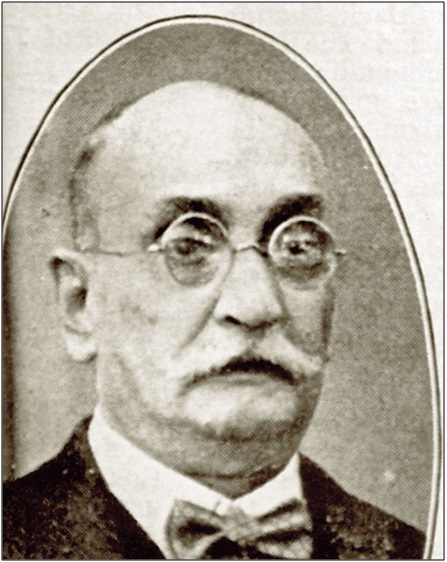

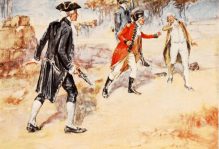

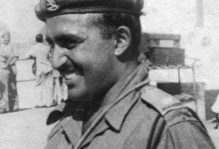

Great informative page. I learned a lot here.
Thank you Malcolm
I would be interested to know more about your Mendies ancestors as I have been doing some research on the Mendies family of Calcutta for several years and presume that yours is an offshoot. Was your grandfather Harold Allen Sidney Mendies born 1916 at Simla who married a Leonie Claudia. (surname unknown) ?.